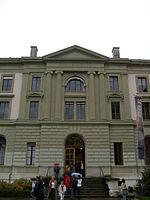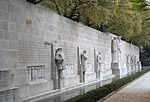Geneva ( jə-NEE-və; French: Genève [ʒənɛv] (listen)) is the second-most populous city in Switzerland (after Zürich) and the most populous city of Romandy, the French-speaking part of Switzerland. Situated in the south west of the country, where the Rhône exits Lake Geneva, it is the capital of the Republic and Canton of Geneva.
The city of Geneva (ville de Genève) had a population of 203,951 in 2020 (Jan. estimate) within its small municipal territory of 16 km2 (6 sq mi), but the Canton of Geneva (the city and its closest Swiss suburbs and exurbs) had a population of 504,128 (Jan. 2020 estimate) over 246 km2 (95 sq mi), and together with the suburbs and exurbs located in the canton of Vaud and in the French departments of Ain and Haute-Savoie the cross-border Geneva metropolitan area as officially defined by Eurostat, which extends over 2,292 km2 (885 sq mi), had a population of 1,044,766 in Jan. 2020 (Swiss estimates and French census).Since 2013, the Canton of Geneva, the Nyon District (in the canton of Vaud), and the Pôle métropolitain du Genevois français (literally 'Metropolitan hub of the French Genevan territory'), this last one a federation of eight French intercommunal councils, have formed Grand Genève ("Greater Geneva"), a Local Grouping of Transnational Cooperation (GLCT in French, a public entity under Swiss law) in charge of organizing cooperation within the cross-border metropolitan area of Geneva (in particular metropolitan transports). The Grand Genève GLCT extends over 1,996 km2 (771 sq mi) and had a population of 1,037,407 in Jan. 2020 (Swiss estimates and French census), 58.4% of them living on Swiss territory, and 41.6% on French territory.Geneva is a global city, a financial centre, and a worldwide centre for diplomacy due to the presence of numerous international organizations, including the headquarters of many agencies of the United Nations and the Red Cross. Geneva hosts the highest number of international organizations in the world. It is also where the Geneva Conventions were signed, which chiefly concern the treatment of wartime non-combatants and prisoners of war. Together with, for instance, New York City (global headquarters of the UN), Basel (Bank for International Settlements), and Strasbourg (Council of Europe), Geneva is a city serving as the headquarters of one of the most important international organizations, without being the capital of a country.In 2021, Geneva was ranked as the world's ninth most important financial centre for competitiveness by the Global Financial Centres Index, fifth in Europe behind London, Zürich, Frankfurt and Luxembourg. In 2019, Geneva was ranked among the ten most liveable cities in the world by Mercer together with Zürich and Basel. The city has been referred to as the world's most compact metropolis and the "Peace Capital". In 2019, Mercer ranked Geneva as the thirteenth most expensive city in the world. In a UBS ranking of global cities in 2018, Geneva was ranked first for gross earnings, second most expensive, and fourth in purchasing power.










